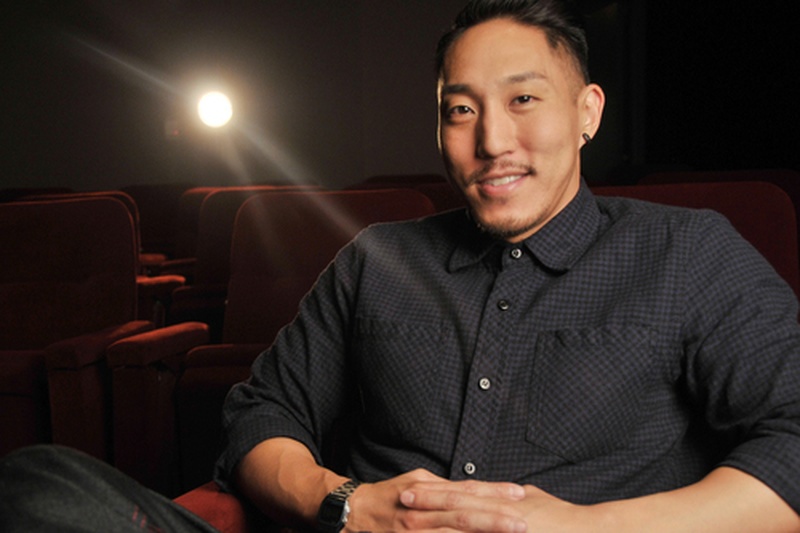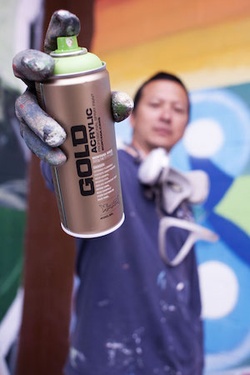I had a chance to sit down and talk with filmmaker Tad Nakamura about his newest documentary Mele Murals and its L.A. Premiere, co-presented by the Japanese American Cultural & Community Center and Visual Communications at the Aratani Theatre on August 5, 2016.
* * * * *
Alison De La Cruz (AD): Can you tell me what was the biggest surprise or learning moment for you on the Mele Murals documentary?
Tad Nakamura (TN): Sure. This project was the first time I really worked with people within the current movement to revive Hawaiian language and culture. As a student in Asian American Studies, and later as part of a broader progressive Asian American community, all you really hear about Hawai‘i is that there is an on-going struggle for sovereignty and that’s it. Working with ʻŌiwi TV and other Hawaiian artists, I never heard the word sovereignty but instead saw how these cultural workers were always talking about the language movement as a tool to connect Hawaiians to each other. I saw how the concept behind the cultural organizing was about building up the community in a way that claimed: we are going to take care of ourselves and build up ourselves.
AD: That’s so interesting because many who have seen your previous work or know you, might see you as a politicized artist or cultural worker. Did this project change your understanding of who you are as an artist who documents individuals and communities?
TN: I don’t think that it necessarily changed my understanding but it deepened my understanding of folks in the cultural movements. You know, the sexy word to describe what we do is cultural worker and I think that’s where we sit. I’ve always identified as a community builder and at one point I was an organizer, but lately I been more of an artist. This project solidified what a cultural worker is to me and the role that cultural workers play in the larger movements for change. I’ve always seen myself as a community builder. That’s why screenings are as important as the film. Screenings bring people from different communities together and create a time and space to be able to meet each other. Sure it’s good to build political and cultural space together with people when we are pissed off and want change. But while making this documentary, I was reminded that we can also connect while we are hanging out and enjoying ourselves as a way to build space with each other.
AD: Seeing this cultural work among Native Hawaiians, did this impact how you think of the Japanese American community?
TD: I’ve always thought of my J.A. community and the threat and what’s happening to Little Tokyo. Then I went to Hawai‘i and met the guys from ‘Oiwi TV and saw how they place their work in a larger cultural context: they are responsible for documenting their entire people’s culture. They see themselves as responsible for retaining a language; and not just protecting a neighborhood like Little Tokyo; but the land itself and their whole people. It blew my mind—I knew what being accountable to a community was like—but here it is on such a larger scale. To be responsible for helping to retain the stories of a whole people and a whole people’s culture so that it will survive, that’s huge. Again, I was struck by how immediate of a threat the possibility of Hawaiian culture and language going away was. But I saw how close these artists are to that past and how vital their role is in the future.
As a Japanese American filmmaker in the context of Hawai‘i, I definitely had to think about the kind of responsibility that I have to acknowledge my privilege and support those who have been oppressed or silenced. Working on this documentary, I also realized that there is so much the JA community can learn about language and cultural revival from Hawaiians. For example—for me as a Yonsei: my grandparents were put in camp so they don’t speak Japanese, neither did my parents. It’s easy to say I didn’t grow up with language, I’m 4th generation, there is no way I can learn the language.
Then I met all these folks working in the Hawaiian community—none of their parents speak the language—they are literally 2 or 3 generations without language and yet, people are taking it upon themselves to bring that language back. I had never thought of it or seen it—a language that was almost buried and dead—and now to see it revived. To see elementary school kids speaking Hawaiian made me think about my own niece and nephew and son and how maybe they could be fluent in Japanese one day. Now that I’ve witnessed it in another community—I can visualize it in my own community.
AD: We have spent some time talking about the ways your film Mele Murals connected you to a Native Hawaiian cultural context. What I love about the film is that by following the artists Estria (pictured right) and Prime (pictured below) we can see how hip-hop speaks to them and through them. Can you talk about any discoveries you made in the interactions between Hawaiian and hip-hop cultures during this project?
TN: The most interesting interaction is that the hip-hop element of the film gets people into the theatre, so then it’s like now that we have your attention—let’s go deeper. I’m not sure how many people will even consider this film hip-hop. I’m curious to find out what will resonate with folks. As we screen around the country, I’m starting to notice that the film definitely resonates with an older generation of hip-hop heads and writers. I’m not sure that the film has that “f*** you” culture or vibe that younger writers tend to have.
AD: I know that some of your previous films are also hip-hop influenced. Can you tell me more about that?
TN: For me, as someone who grew up as part of the hip-hop generation, it’s almost something that I take for granted. That goes to show how much of an impact hip-hop has had on me. It’s up to debate on how much power hip-hop has on this current generation—but our generation was/is definitely impacted. Hip-hop was my entry to arts and the creative world—even as a filmmaker’s son—creating art wouldn’t have been as appealing if I hadn’t been exposed to hip-hop.
AD: I think that our generation has lots to say about how hip-hop has changed since we were kids.
TN: As much as hip-hop has been commercialized, there is still a lot of potential in its foundation (liberation, resistance, and youth culture)—those are always going to be there. Even as washed out as it is in mainstream hip-hop, these Hawaiian kids spray-painting a wall (even though it’s old school) is such a specific type of empowerment that is strictly hip-hop. It’s that taste of liberation not only against systems and states but it’s against your parents and your teachers. It’s a youth movement. Hip-hop still has those fundamental elements.
AD: We talked earlier about the ways that you as a Japanese American are navigating your place within a Native Hawaiian context. When I think about conversations that you and I have had about this, it links up to conversations we as Asian Americans and Pacific Islanders can have about our relationships to hip-hop culture. Are we appropriating? Innovating? Participating in hip-hop culture and its roots?
TN: For me, my models of American activism and empowerment are rooted in African American and Black culture. Liberation movements have been happening all over the world for ages but the methods of organizing and cultural work that personally shaped me come from the black power movement. If some people consider that appropriation—then I have no problem fessing up to that and I am open to getting checked. I am definitely interested in discovering how to make all of my hip hop-informed work more participation than appropriation. Just like Jazz—dues need to be paid to black culture and black music—it still inspires me and I chose to be a part of it and contribute.
One of the themes of this film is new ways to teach the old. I think it offers all audiences ways to consider: What aspects of our cultures or ourselves do we need to keep? What aspects are we willing to change? Is our struggle with the form or the purpose?
It’s not one or the other—the goal is to find new ways to carry on the traditional. I think it’s up to the people WITHIN their different cultures to figure out what, if anything, needs to evolve.
*This article was originally published by the Japanese American Cultural & Community Center on July 29 and August 4, 2016.
© 2016 Alison De La Cruz





